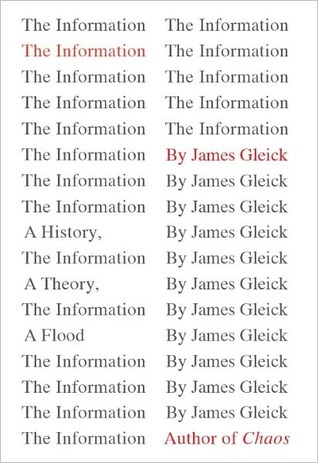More on this book
Community
Kindle Notes & Highlights
Information theory began as a bridge from mathematics to electrical engineering and from there to computing.
“What lies at the heart of every living thing is not a fire, not warm breath, not a ‘spark of life,’ ” declares the evolutionary theorist Richard Dawkins. “It is information, words, instructions. . . . If you want to understand life, don’t think about vibrant, throbbing gels and oozes, think about information technology.” The cells of an organism are nodes in a richly interwoven communications network, transmitting and receiving, coding and decoding. Evolution itself embodies an ongoing exchange of information between organism and environment.
grandiloquence
bombast?
loquacious
phoneme
Redundancy—inefficient by definition—serves as the antidote to confusion. It provides second chances. Every natural language has redundancy built in; this is why people can understand text riddled with errors and why they can understand conversation in a noisy room. The natural redundancy of English motivates the famous New York City subway poster of the 1970s (and the poem by James Merrill), if u cn rd ths u cn gt a gd jb w hi pa!
efficacious.
For this invention will produce forgetfulness in the minds of those who learn to use it, because they will not practice their memory. Their trust in writing, produced by external characters which are no part of themselves, will discourage the use of their own memory within them. You have invented an elixir not of memory, but of reminding; and you offer your pupils the appearance of wisdom, not true wisdom.
coterminous
petroglyphs—
There is a progression from pictographic, writing the picture; to ideographic, writing the idea; and then logographic, writing the word.
syllabary,
In all the languages of earth there is only one word for alphabet (alfabet, alfabeto, , ). The alphabet was invented only once. All known alphabets, used today or found buried on tablets and stone, descend from the same original ancestor, which arose near the eastern littoral of the Mediterranean Sea, sometime not much before 1500 BCE, in a region that became a politically unstable crossroads of culture, covering Palestine, Phoenicia, and Assyria.
paleographer
accretion,
noetic
As for Robert Cawdrey, his mark on history ends with the publication of his Table Alphabeticall in 1604.
asymptotically
sardonic
“The circle of the English language has a well-defined centre but no discernable circumference.”
caprice
idiolect,
mitosis.
multifarious
rhapsodized
Abu Abdullah Mohammad Ibn Musa al-Khwarizmi, whose name survives in the word algorithm,
simulacra
inimical
“daguerreotype”
efface
Inspiring him, as well, was the loom on display in the Strand, invented by Joseph-Marie Jacquard, controlled by instructions encoded and stored as holes punched in cards.
damask,
You know I am by nature a bit of a philosopher, & a very great speculator, —so that I look on through a very immeasurable vista, and though I see nothing but vague & cloudy uncertainty in the foreground of our being, yet I fancy I discern a very bright light a good way further on, and this makes me care much less about the cloudiness & indistinctness which is near.—Am I too imaginative for you? I think not.
It would be, he said, “a locomotive that lays down its own railway.”
Ralph Waldo Emerson had met Babbage in London and declared in 1870, “Steam is an apt scholar and a strong-shouldered fellow, but it has not yet done all its work.” It already walks about the field like a man, and will do anything required of it. It irrigates crops, and drags away a mountain. It must sew our shirts, it must drive our gigs; taught by Mr. Babbage, it must calculate interest and logarithms. . . . It is yet coming to render many higher services of a mechanico-intellectual kind.
“Every shower that falls, every change of temperature that occurs, and every wind that blows, leaves on the vegetable world the traces of its passage; slight, indeed, and imperceptible, perhaps, to us, but not the less permanently recorded in the depths of those woody fabrics.”
Suppose, instead, he suggested, post towns were linked by a series of high pillars erected every hundred feet or so. Steel wires would stretch from pillar to pillar. Within cities, church steeples might serve as the pillars. Tin cases with wheels would roll along the wires and carry batches of letters. The expense would be “comparatively trifling,” he said, “nor is it impossible that the stretched wire might itself be available for a species of telegraphic communication yet more rapid.”
Some years before his death, he told a friend that he would gladly give up whatever time he had left, if only he could be allowed to live for three days, five centuries in the future.
stuccoed
gutta-percha.
antagonistic
To perfect this complex mechanism Chappe enlisted Abraham-Louis Breguet, the well-known watchmaker.
gimcrack
taciturn
The telegraph enabled people to think of weather as a widespread and interconnected affair, rather than an assortment of local surprises.
vitiate
metonymically
recondite.
dilettantes


